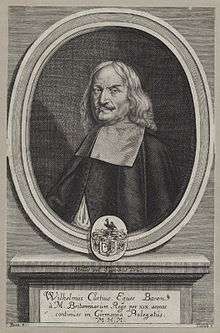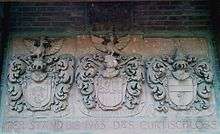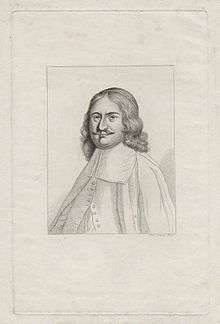Sir William Curtius
William Curtius (1599–1678), 1st Curtius Baronet of Sweden, FRS, was a diplomat representing the House of Stuart during the Thirty Years' War and the exile of Charles II. In later life, he served as Resident Ambassador of the English Crown in the Holy Roman Empire,[1] and was head magistrate for two districts of the Electoral Palatinate. [2] [3]

The Curtius Baronetcy of Sweden was a title in the Baronetage of England,[4] created on 2 April 1652 for William Curtius, "Resident to the King of Sweden".[5]
In Germany, Curtius was known as Wilhelm von Curti, where from 1654 he lived in Castle Curti in Umstadt, Hesse.
Early life

The di Curti family were Italian lower nobility from the Lombardian region around Gravedona. Branches of the family moved along Lake Geneva and the river Rhine (ex allobrogius) to the German area of the Electoral Palatinate. Sir William's father settled at the city of Bensheim, where Curtius was born in 1599.[7][8][9]
On seeing his son's above-average talent, Curtius' father sent him first to prepare for university studies in the Calvinist Collegium Casimirianum in Neustadt an der Haardt. His studies at the University of Heidelberg were disrupted by the initial events of the Thirty Years War.[9] Curtius moved to the Calvinist Herborn Academy in 1621,[10] where he studied with Alstedius, "the Encyclopediast".[11] After two years of study at Herborn, Curtius enrolled at the Academy of Geneva, the spiritual stronghold of the Reformed Church.[12] In 1627, he enrolled at the Sorbonne; he concluded his studies at the University of Siena.[9]
English diplomat

Early in the Thirty Year's War Curtius' homeland, the Palatinate, was occupied by Habsburg and Catholic League forces, after the Holy Roman Emperor Ferdinand II decisively defeated the Elector Palatine Frederick V at the 1820 Battle of White Mountain and replaced him as King of Bohemia. The exiled Frederick and his wife Elizabeth Stuart received military and diplomatic support from the Protestant kingdoms of England and Scotland, which were ruled by Elizabeth's brother King Charles I. The successful 1830 invasion of the Holy Roman Empire by the Swedish King, Gustavus Adolfus, gave them new hope of reclaiming their Palatinate lands and their titles as King and Queen of Bohemia.
Curtius was employed as a secretary to Frederick from 1629, possibly on the recommendation of his friend Joachim, son of the Palatinate administrator Ludwig Camerarius.[1]
In 1632, King Charles sent his senior courtier Henry Vane to the Swedish King to seek stronger support for the Palatine cause. Vane employed William Curtius as his secretary for the mission.[13] As secretary, Curtius carried letters and messages between the key players. He returned from his first visit to England with letters recalling Vane but entrusting him to continue Vane's work. In return for a salary of 1,000 pounds per month, he was appointed as resident of the English Crown to the King of Sweden.[1]
It was in this English role that he was one of the last people to meet with the Elector Palatine in November 1632, when Frederick was already displaying early symptoms of the plague that killed him only days later.[14]
Curtius remained in Germany as an Agent of Charles I of England until November 1633.[15][16]
In the Palatine service
Curtius visited London several times during the 1630s.
In 1633, the Administrator of the Palatinate sent Curtius back to London to seek King Charles' financial support to raise garrisons for the Palatinate fortresses liberated by the Swedish.[17]
Curtius was based in London into 1634,[1] hoping to be further employed by Charles I. Elizabeth Stuart wrote to diplomat Sir William Boswell in his support,
I pray remember what I saide to you about Curtius that if the king my deare Brother will not keep him in his service, he may be dismissed with his favour, and the sooner the better for the poore man is there [in London] on his own purse and cannot be paid what is owing of him. [18]
He attended a joint assembly of Protestant princes in Frankfurt in April. Late in the year, he returned to Elizabeth's exiled court at The Hague, having failed to secure material English support for the Palatinate cause.[1]
Curtius was back in London in 1636 as chaperone for Elizabeth's teenage sons Charles Louis and Prince Rupert.[19] He reported back to Elizabeth in great detail on various discussions and negotiations that Charles Louis had had with King Charles and others, seeking funds and other support.
English Resident in Germany
Curtis again took up an official English role [20] when Charles I appointed him as representative of England at the Imperial Diet of Nürnberg in 1639 and 1649, and at Frankfurt in 1642. He also supported Sir Thomas Roe in Vienna in 1641–42.[15](p63)[21]
At the same time, Curtius represented Kurprinz Charles Louis as a member of the Palatine Council working to have the Elector Palatine's lands returned to him.[1]
Curtius was appointed by Charles I as official resident of the English Crown in the Holy Roman Empire in 1645.[1] In 1652, when he was appointed to the Baronetcy by the then-exiled Charles II, Curtius was "resident for his majesty, with Gustavus, King of Sweden, and the princes of Germany".[4] Charles II described him as "borne in these partes, and long imployed there by our father of blessed memory" [22]
On 5 August 1664, four years after Charles II's Restoration, Sir William was appointed Resident Ambassador at Frankfurt am Main, and remained so until recredentialled in September 1677.[4][15]:146
German governor
Curtius was appointed Oberamtmann – Bailiff, or District Governor – in Umstadt from 1650 to 1672. [2] At that time, half the city was owned by the Palatinate as a condominium with the changing successors of the Landgraviate of Hesse: the Landgraviate of Hesse-Darmstadt, Landgraviate of Hesse-Kassel and Hesse-Rheinfels.[2]
During this time, he was appointed to the Imperial Nobility, the "Reichsadel".[24]
Fellow of the Royal Society
Sir William was elected as a Fellow of the Royal Society on 3 October 1667.[25][26] He corresponded with both Henry Oldenburg, the Secretary of the Society, and Gottfried Leibniz, bringing the latter a copy of Wilkin's Encyclopaedic Essay.[27]
"Mr Oldenburg read a Latin letter to himself from Sir William Curtius dated at Umbstad December 2 1668 containing assurances of his willingnese to send what philosophical communications he could out of Germany and particularly from the Elector of Mentz and from the physician of the Landgrave of Hesse Darmstadt. This letter was ordered to be entered in the Letter Book." [28]
Family and legacy
Curtius may have lost a family during the thirty year's war.[1] On his return to the Palatinate, he married Catharina Fabricius gennant von Gressinich; her father Peter Fabricius was a Palatinate judge, her mother Anna Hoeufft[3] was the sister of Jan Hoeufft, Dutch treasurer to Louis XIV of France.[29]:542
After Catharina's death in 1652, Curtius married the widow of the mayor of Frankfurt, Anna Sibylla von Stalburg, who was born to a Viennese banking family.
His son, Sir Johann William, succeeded as the second Baronet Curtius and as Oberamtmann in Umstadt from 1681 to 1691.[2]
In popular culture
In the novel Quicksilver, Neal Stephenson quotes from The History of the Royal Society of London,[30] in which "the president produced from Sir William Curtius a hairy ball found in the belly of a cow". [31]
| Baronetage of the United Kingdom | ||
|---|---|---|
| Preceded by New creation |
Baronet (of Sweden) 1652–1678 |
Succeeded by Sir Carl William Curtius |
References
- Großkopf, Gertrud (1987). "Wilhelm Curtius. Lebensspuren eines kurpfälzischen Adeligen aus Bensheim im Dienst der englischen Krone" [William Curtius. The path of a Palatine nobleman, from Bensheim to the service of the English Crown]. In Historischer Verein für Hessen (ed.). Archive für hessische Geschichte und Altertumskunde (in German). Neue Folge 45. Band 1987. ISSN 0066-636X.
- Widder, Johann Goswin (1 January 1787). Versuch einer vollständigen geographisch-historischen Beschreibung der kurfürstl. Pfalz am Rheine. Band 2. (A geographic history of the Palatine Electorate, volume 2). Frankfurt und Leipzig: Dritter Zheil. p. 4. Retrieved 25 August 2015.
- Wilhelm von Curti, Biography of Hesse, at: Landesgeschichtliches Informationssystem Hessen (LAGIS) in Germany
- Heyleyn, Peter (1773), Help to English History: Containing a Succession of All the Kings of England ... the Kings and Princes of Wales; the Kings and Lords of Man: and the Isle of Wight. As Also of All the Dukes, Marquises, Earls and Bishops Thereof ... Together with the Names and Ranks of the Viscounts, Barons, and Baronets, of England, p. 475
- Cokayne, George E. (1900), Complete Baronetage, Exeter: W. Pollard & co., ltd.
- German secondary school qualifying for university admission or matriculation
- S. Scholz: Die Inschriften des Landkreises Bergstrasse, part 12, publ. house Reichert, 1994, p. 173-174
- Genealogisches Handbuch des Adels, part 52, page 254
- Peter Schröck-Schmidt. "Wilhelm Curti. Ein kurpfälzischer Adliger aus Bensheim und sein Schloß in Groß-Umstadt". In Herausgber: Der Magistrat der Stadt Groß-Umstadt (ed.). 1250 Jahre Gross-Umstadt 743-1993 (in German). Geiger-Verlag, Horb am Neckar. pp. 194–198.
-
"HStAD Fonds R 21 C 1 No NACHWEIS". Hessisches Staatsarchiv Darmstadt.
The matriculation entry of the University of Heidelberg dated 24.11.1619 refers to the origin of Curtius, where he was inscribed as 'Johannes Wilhelmus Curtius Bensheimensis Palatinus'; on 1.10.1621 he was enrolled in Herborn.
- Evelyn, John; Bray, William (1850). Diary and Correspondence of John Evelyn, to which is Subjoined the Private Correspondence Between King Charles I and Sir Edward Nicholas, and Between Sir Edward Hyde and Sir Richard Browne. Colburn. p. 267. Retrieved 20 March 2015.
- Stelling-Michaud, Suzanne. Le livre du recteur de l'Academie de Genève: (1559–1878), Volume 6 (in French). Librarie E. Droz. p. 166.
- Collins, Arthur (1812), Peerage of England, England: F. C. and J. Rivington, p. 509
- Green, Mary Anne Everett (1854), Lives of the Princesses of England: From the Norman Conquest, Volume 5, H. Colburn, p. 508
- Bell, Gary M. (1995), Handlist of British Diplomatic Representatives, 1509–1688, Cambridge: Cambridge University Press, pp. 146, 274
- Allen B Hinds, ed. (1921). "Venice: November 1633". British History Online. Calendar of State Papers Relating To English Affairs in the Archives of Venice, 1632–1636. London. p. 159–168. Retrieved 3 January 2018.
- Allen B Hinds, ed. (1921), "Venice: December 1633", British History Online, Calendar of State Papers Relating To English Affairs in the Archives of Venice, 1632–1636, London, Volume 23, pp. 168–178, retrieved 3 January 2018
- Queen Elizabeth (Consort of Frederick King of Bohemia) (2011) [1634], Akkerman, Nadine (ed.), The Correspondence of Elizabeth Stuart, Queen of Bohemia, Oxford: Oxford University Press, p. 274, ISBN 978-0-19-955108-8
- Akkerman, Nadine (2011). "Letter 246". The Correspondence of Elizabeth Stuart, Queen of Bohemia. p. 139. ISBN 9780199551088.
- "Letter 432", Elizabeth in The Hague to Roe (in Hamburg)
- Brown, Michael J. (2015). Itinerant Ambassador: The Life of Sir Thomas Roe. University Press of Kentucky. p. 264.
- Calendar of the Clarendon State Papers Preserved in the Bodleian Library 1649–1657, ed. by the Rev. W. Dunn Macray. Great Britain: Clarendon press. 1869. pp. 166.
william curtius.
- The Standing Council of the Baronetage. "A short history".
- Euler, Friedrich Wilhelm (1966). "Bensheimer Leute". 1200 Jahre Bensheim. Darmstadt. pp. 344–346.
- "Fellowship of the Royal Society".
- Thomson, Thomas (1812). History of the Royal Society, from Its Institution to the End of the 18 Th Century. London: Baldwin. p. xxv, Appendix IV.
- Maat, Jaap (2012). Philosophical Languages in the Seventeenth Century: Dalgarno, Wilkins, Leibniz. Springer Science & Business Media. p. 298. ISBN 9789400710368.
- Birch, Thomas (1756). History of the Royal Society of London for Improving of Natural Knowledge from Its First Rise, in which the Most Considerable of Those Papers Communicated to the Society, which Have Hitherto Not Been Published, are Inserted as a Supplement to the Philosophical Transactions. 2. A. Millar in the Strand. pp. 336, 337.
- Hippolyte, Louis Édouard Marie, comte de Dienne (1891). Histoire du desséchement des lacs et marais en France avant 1789. Paris: H Champion. Retrieved 6 October 2018.
- Birch, Thomas (1756). the History of the Royal Society of London for Improving of Natural Knowledge from Its First Rise ... As a Supplement to the Philosophical Transactions, Volume 1.
- Stephenson, Neal (2003). Quicksilver (The Baroque Cycle No. 1). William Heinemann Ltd.